|
|
| |
|
|
 |
|
|
| Concrete
blocks are all that remain of the extensive WW2 defences
along the beach at Forvie Colvid0017 |
| |
|
|
| |
|
|
| |
Norwegian
pass |
|
| |
| |
A
form written in English and Norwegian, signed by a Norwegian
Brigadier and dated 29th December 1941. The pass was
issued to Lewis Mackie, a coast watcher and temporary
coastguard, to identify him to any Norwegian Forces
which he might meet while on patrol from Collieston
to the mouth of the River Ythan, part of the area also
covered by the Norwegian Brigade during the 1939-1945
World War.
Once while on patrol Lewis discovered a partly hidden
dinghy which had been brought up from the shore by some
Germans landing from a submarine. The Germans were eventually
caught further north in Moray.
|
|
 |
| |
|
|
| |
"Hitler" |
|
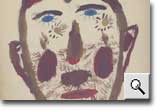 |
Jack
Walker, whose father Thomas saw active service in the
Dardanelles during the First World War, was a child
of thirteen when the Second World War broke out. Like
so many of his contemporaries, Jack kept a scrapbook
which he began compiling after the death of King George
V in 1937.
Among the many newspaper cuttings adorning the pages
of the wartime years of the scrapbook are some of Jack’s
own cartoon drawings of his heroes and villains. Judging
by Jack’s depiction of Hitler, he clearly fell
into the latter category.
Jack, a cadet in the Merchant Navy, went on to study
at the School of Navigation in Aberdeen and by the end
of the war in 1942 Jack, then a young man, had seen
action in the Mediterranean during the Italian Campaign.
|
| |
|
|
| |
|
|
| |
Collieston
men during World War 1 |
|
| |
| |
Three fishermen
from the village who fought in the Great War of 1914-1918.
George Buthlay (seated left) saw active service in France
on the Western Front. Andrew Mitchell (standing centre)
also fought in France on the Western Front and served
in the Royal Artillery.
Thomas Walker (seated right) served in the Drake Battalion
Royal Naval Division. This special unit of soldiers
in the Royal Navy was sent to attack ports. Thomas saw
active service in the Dardanelles. All three men returned
home safely to Collieston after their wartime service.
Andrew Mitchell and Thomas Walker lived next door to
one another in the Low Town area of the village in cottages
known at one time as Jubilee Terrace, the houses having
been built in 1887 the year of Queen Victoria's Golden
Jubilee. It is interesting to note that the cottages
are still inhabited by members of their families.
|
|
 |
| |
|
|
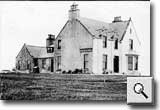 |
| Slains
Lodge becomes a military billit |
| |
Whiteness
Hotel, viewed from the north circa 1890, stands on
a cliff top location in the High Town area of Collieston.
Built in the latter half of the 19th Century and consisting
of some thirty rooms, it was eventually closed in
June 1911 after many of the locals, particularly the
women, objected to the hotel's well-attended drinking
sessions.
The building was later extended into a shooting lodge
and during World War Two it was requisitioned by the
Army when Forvie was used as a training ground. By
the end of the 20th Century it had been converted
into three individual flats.
The smaller two-storey building seen to the left of
the main building was the original public bar and
servants' quarters.
|
| |
|
|
| |
|
|
| |
Home
on leave during World War 1 |
|
| |
An Army Officer home on leave in
1916. Accompanied by friends and relatives, the
young officer is enjoying a welcome break far from
the hostilities of World War One. The group of people
are seated on a wooden bench near the foreshore
on a sunny day in summer.
The houses in the distance are situated on the part
of the village known as the Cliff. The grassy mound
behind them, the 'Rivie' (the promontory which divides
Cransdale from Collieston), is where the 'herdie
lad' would have looked after the dairy cows.
|
|
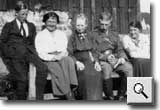 |
| |
Sorting
sphagnum moss during World War 1 |
|
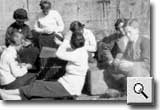 |
A
group of people are sorting sphagnum moss on the Pier
in 1916. During World War One there was an urgent
need for emergency field wound dressings and sphagnum
moss, with a natural chemical substance that could
aid healing, complete with a natural antiseptic, was
much sought after.
Sphagnum moss grew in abundance on the Forvie Moors,
to the south of Collieston. Groups of people would
pick the sphagnum moss and carry it back to the village
where it would be sorted before being despatched to
field hospitals.
|
| |
|
|
| |
Sphagnum
moss |
|
| |
Sphagnum
Moss, found in abundance on the moors of the Forvie
National Nature Reserve, was in great demand as a field
dressing during World War One. With a natural chemical
substance that could aid healing, complete with a natural
antiseptic, the common plant was much sought after.
In addition to its ability to absorb several times its
own weight in water (liquid or blood), Sphagnum Moss
was also light to carry, making it ideal for carrying
as an in-pocket field dressing.
|
| |
|
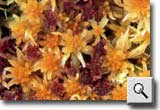 |
| |
Hitler
the monkey |
|
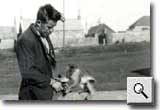 |
Jimmy
Ingram and Hitler the monkey. Jimmy’s brother,
Dick, was a merchant seaman who travelled all round
the world in the 1930’s and 40’s. It was
during one of his trips that Dick sent home a monkey
from West Africa to his parents in Collieston.
The monkey was given the name Hitler and was a great
source of fascination for the villagers, especially
the children. Hitler, unfortunately, soon earned a reputation
as fiercesome as his namesake and it was not unknown
for him to bite an inquisitive hand.
The only person who could exert any control over the
monkey was Dick’s brother, Jimmy. He became very
attached to Hitler and was probably the only person
in Collieston to shed a tear when the monkey eventually
had to be put down.
|
| |
|
|
| |
|
|
| |
The granite War Memorial in Collieston churchyard
commemorates thise men of the parish who were killed
during the First World War. Eighteen local men gave
their lives serving in all branches of the armed forces
as well as in the Merchant Navy.
|
| |
|
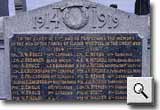 |
To listen to the files you will need to have the Quicktime
media player installed on your machine. If you do not have
the player, it can be downloaded from here []
|
|
|
talks about his father’s
role as a Coastwatcher during WW2, as well as
describing a pass that was issued by a Norwegian
Brigadier. |
links a near miss
to his courting of the girl who was
to become his wife.
|
 |
|
 |
describes a night when the
church bells rang to warn of an invasion. |
| talks about an incident
when a stray mine blew up. |
 |
|
 |
talks about the evacuee children that arrive
in Collieston during WW2.
|
|
 |
tells more about her life in Collieston as
an evacuee.
|
| describes the arrival
of evacuee children from Glasgow. |
 |
|
 |
tells how “Hitler”
the monkey came to live in Collieston.
|
| talks about how she and her
friends kept themselves amused in Collieston
during WW2 |
 |
|
 |
talks about WW2 and when the army came to Collieston
|
| describes the incident when as a teenager
he was injured following his discovery of a piece
of unexploded British ordinance on Forvie Moor |
 |
|
|
|
|
|
|
|
|
|
copyright
collieston's century 2003 |
|